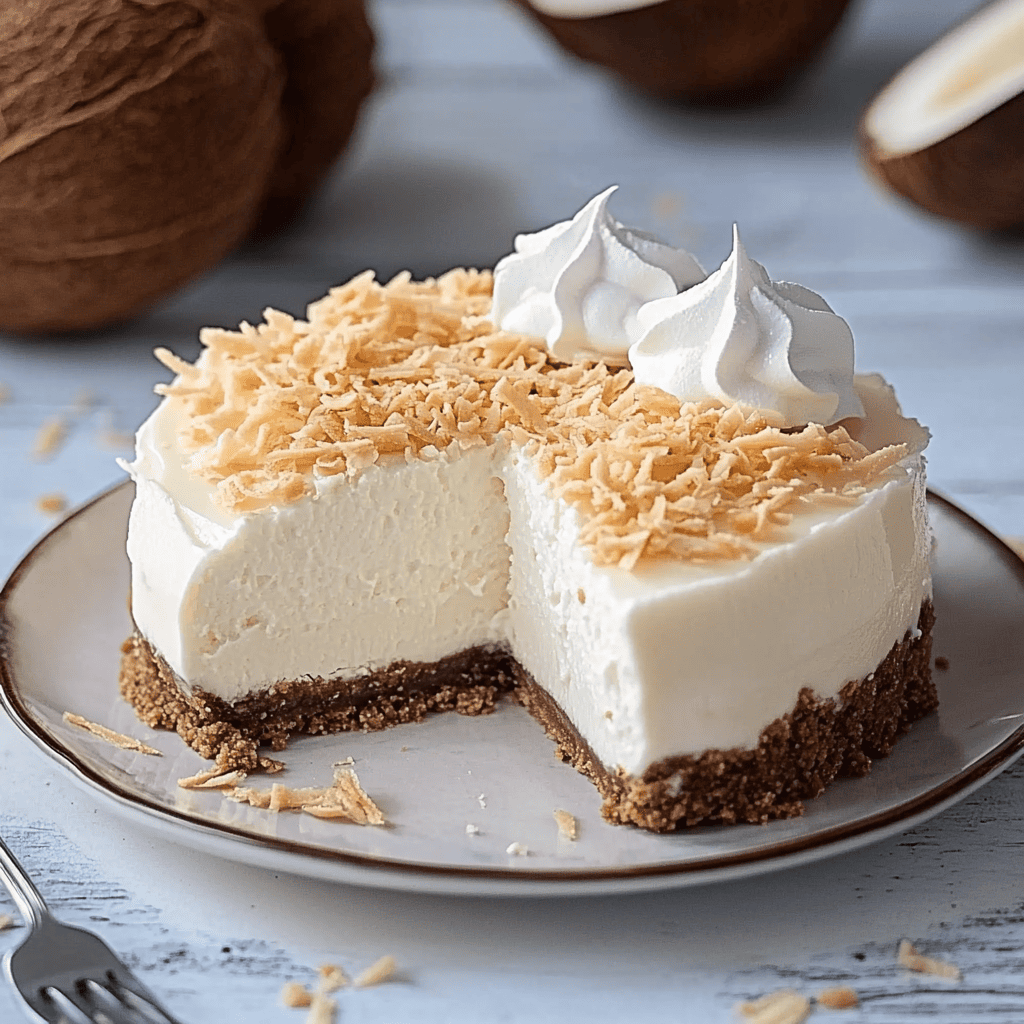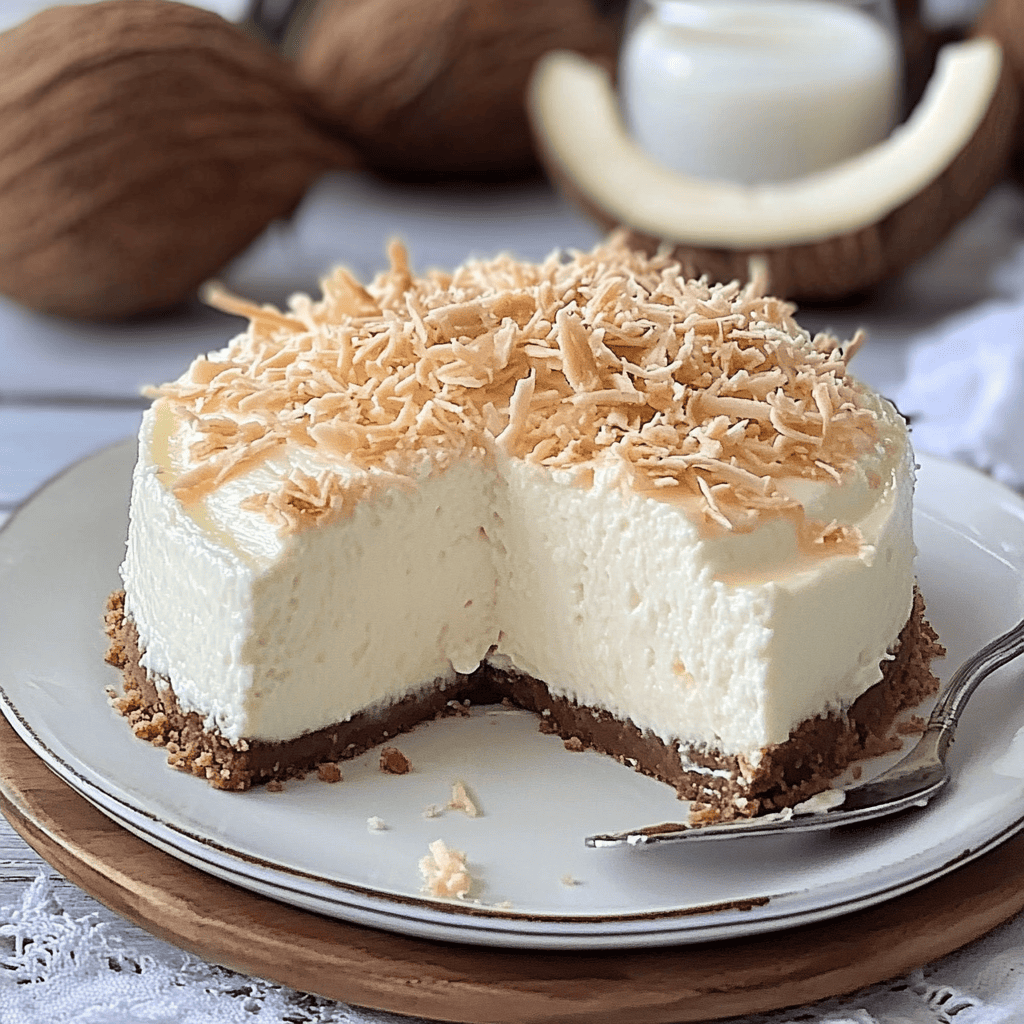Coconut Cheesecake: An Exotic Dream of Creaminess and Tropical Flavor
Introduction: A Sophisticated Dessert with a Tropical Soul
Coconut Cheesecake is a delicious twist on the classic cheesecake that incorporates the exotic, sweet flavor of coconut in every layer. From the crunchy cookie base to the creamy, smooth filling with coconut milk and shredded coconut, topped with a layer of whipped cream and a generous sprinkle of coconut, this dessert is a true delight for lovers of tropical flavors. Its rich texture and refreshing flavor make it a perfect choice for any occasion, transporting your senses to paradisiacal beaches with every bite. Discover all the secrets of this exquisite cheesecake!
Detailed History in Spanish: Uniting Tradition and an Exotic Touch
The history of cheesecake dates back to ancient Greece, where a type of cheesecake was prepared for athletes during the Olympic Games. However, the modern cheesecake, with its biscuit base and creamy cream cheese filling, has its roots in the United States in the late 19th century.
Modern Cheesecake: The modern version of cheesecake was popularized in New York and became an iconic dessert. Its main characteristics are its crushed biscuit base and soft filling made of cream cheese, sugar, and eggs.
The Incorporation of Coconut: The addition of coconut to cheesecake is a more recent adaptation, driven by the growing popularity of tropical flavors in Western cuisine. Coconut, native to tropical regions around the world, contributes a natural sweetness, a distinctive aroma, and an interesting texture to desserts.
The recipe for Coconut Cheesecake likely emerged from the experimentation of chefs and baking enthusiasts looking to give the classic cheesecake an exotic and refreshing twist. Coconut milk, shredded coconut, and coconut essence are key ingredients to achieve that distinctive tropical flavor.
More Historical Detail: Tropical Influences and Adaptations
Digging a little deeper into the history of Coconut Cheesecake, we can consider some possible influences:
- Coconut Desserts in Tropical Cultures: Coconut is a fundamental ingredient in the baking of many tropical cultures, used in a wide variety of sweets and desserts for its flavor and versatility. Incorporating this ingredient into a Western dessert like cheesecake is an example of a fusion of flavors and culinary traditions.
- The Quest for New Flavors in Baking: Baking is constantly evolving, with chefs and enthusiasts seeking new combinations of flavors and textures to surprise and delight diners. Adding coconut to cheesecake is a response to this quest for innovation.
- The Popularity of Exotic Flavors: As people become more adventurous in their culinary tastes, exotic flavors such as coconut, mango, pineapple, and passion fruit have gained popularity in desserts and other preparations.
Coconut Cheesecake can be presented in different versions, from baked cheesecakes to cold, unbaked cheesecakes, using gelatin to give them firmness. Adding a top layer of whipped cream and shredded coconut is a common way to enhance its flavor and presentation.

Ingredients & Detailed Preparation
Ingredients:
For the base:
- Digestive biscuits or Maria biscuits: 200 g
- Melted butter: 100 g
- Shredded coconut: ½ cup (optional)
For the filling:
- Cream cheese (Philadelphia type): 500 g (At room temperature)
- Whipping cream (liquid cream): 200 ml (Cold)
- Condensed milk: 1 can (397 g)
- Coconut milk: ½ cup
- Shredded coconut: 1 cup (dehydrated or fresh)
- Unflavored gelatin (powder): 2 tablespoons
- Cold water: ¼ cup (to dissolve the gelatin)
- Vanilla essence: 1 teaspoon
For decoration (optional):
- Whipped cream
- Toasted shredded coconut
- Fresh coconut pieces
Detailed Preparation:
- Prepare the base: Crush the Digestive or Maria biscuits into fine crumbs. You can do this with a rolling pin inside a bag or with a food processor.
- In a bowl, mix the cookie crumbs with the melted butter and shredded coconut (if using).
- Press the cookie mixture into the base of a springform pan, approximately 8-9 inches in diameter, creating an even layer. Refrigerate while you prepare the filling.
- Prepare the gelatin: In a small bowl, sprinkle the unflavored gelatin over the cold water and let it sit for about 5-10 minutes to hydrate.
- Heat the hydrated gelatin in the microwave or in a double boiler until completely dissolved and liquid. Do not let it boil. Set aside.
- Prepare the filling: In a large bowl, beat the room temperature cream cheese with an electric mixer until smooth and lump-free.
- Add the condensed milk and coconut milk to the cream cheese and continue beating until well combined.
- Add the grated coconut and vanilla essence to the mixture and mix well.
- In a separate bowl, beat the cold whipping cream with an electric mixer until stiff peaks form.
- Stir in the gelatin and whipped cream: With the mixer on low speed, slowly pour the dissolved gelatin into the cream cheese and coconut mixture, beating until well combined.
- Using a spatula, gently fold the whipped cream into the cheese and coconut mixture until well combined.
- Pour onto the crust and refrigerate: Pour the filling mixture onto the cookie crust in the pan. Smooth the surface with a spatula.
- Cover the pan with plastic wrap and refrigerate for at least 4-6 hours, or preferably overnight, so the cheesecake can firm up completely.
- Unmold and decorate (optional): Once the cheesecake has set, carefully remove the ring from the pan. Decorate the top with whipped cream, toasted shredded coconut, and/or fresh coconut pieces if desired.
- Serving: Serve the Coconut Cheesecake cold and enjoy its delicious tropical flavor.
Estimated Preparation Time
- Preparation: 30-40 minutes (crush cookies, mix base and filling)
- Cooling: Minimum 4-6 hours (ideally overnight)
- Decoration (optional): 10-15 minutes
- Total time: Approximately 40-55 minutes + cooling time
Additional Tips
- Intensify the coconut flavor: You can lightly toast the shredded coconut before adding it to the filling to intensify its flavor. You can also use coconut essence in addition to coconut milk.
- Alternative base: If you don’t have Digestive or Maria biscuits, you can use other dry biscuits of your choice.
- No-Bake Cheesecake: This recipe is for a no-bake cheesecake, which gets its firmness from refrigeration and gelatin.
- Creative decoration: In addition to shredded coconut, you can decorate with white chocolate shavings, mint leaves, or even a tropical fruit sauce.
- Ensure firmness: It is crucial to refrigerate the cheesecake long enough for it to firm properly and not crumble when cut.

Frequently Asked Questions
- Can I use canned coconut milk instead of cartons? Yes, you can use canned coconut milk, but be sure to use only the liquid portion and not the solid cream that sometimes forms on top.
- Can I make this cheesecake without gelatin? Without gelatin, the cheesecake won’t have the same firmness and will likely be softer and creamier, similar to a mousse. It won’t cut as cleanly.
- How long does this cheesecake last in the refrigerator? If tightly covered, the Coconut Cheesecake can be stored in the refrigerator for 3-4 days.
Texture and Flavor
The texture of this Coconut Cheesecake is rich, creamy, and smooth, almost like a firm mousse thanks to the gelatin. The biscuit base provides a pleasant, crunchy contrast. The shredded coconut scattered throughout the filling adds small touches of fibrous and chewy texture.
The flavor is predominantly sweet and tropical, with the delicious taste of coconut in each layer. The biscuit base provides a neutral, slightly sweet flavor. The filling combines the richness of cream cheese with the sweetness of condensed milk and the exotic, refreshing taste of coconut milk and shredded coconut. Vanilla essence adds a subtle aromatic touch that complements the other flavors.
Consumer Context
This Coconut Cheesecake is perfect for various occasions:
- Dessert for celebrations: Its exotic flavor and elegant presentation make it ideal for parties, birthdays, and other special celebrations.
- Informal gatherings: It is a delicious and easy dessert to share at gatherings with friends and family.
- A tropical treat: Perfect for when you crave a dessert with a refreshing and exotic flavor.
- After a meal: Its balanced sweetness makes it a pleasant ending to any meal.
- For coconut lovers: If you’re a fan of coconut, this cheesecake is sure to become one of your favorite desserts.
Visual Aspect
Coconut Cheesecake has a very attractive visual appearance. Its creamy white color, dotted with white shredded coconut, evokes purity and freshness. The light brown biscuit base provides a pleasing visual contrast. The top layer, often decorated with whipped cream and more shredded coconut (sometimes toasted for a golden touch), makes it even more appetizing. Mint leaves or white chocolate shavings can add an extra touch of elegance.
Curiosities
- Coconut and its many uses: Coconut is a very versatile fruit used in the cuisine of many tropical cultures in various forms: milk, water, oil, grated, etc.
- Gelatin in baking: Gelatin is a key ingredient in many no-bake desserts, providing structure and firmness without the need for baking.
- Cheesecake Around the World: Although New York cheesecake is the most well-known, there are many variations in different countries, with local ingredients and techniques.
Nutritional Value (Estimated per Serving)
Please note that these values are approximate and may vary depending on the serving size and exact amounts of ingredients used.
- Calories: 350-450 kcal
- Protein: 8-10 g (mainly from cream cheese and cream)
- Fat: 25-35 g (mainly from cream cheese, cream and butter)
- Saturated fat: 15-25 g
- Carbohydrates: 25-35 g (mainly from sugar in condensed milk and cookies)
- Sugars: 20-30 g
- Fiber: 1-2 g (from coconut and cookies)
- Vitamins and Minerals: Provides some calcium (from dairy) and small amounts of other nutrients.
Additional Benefits and Interesting Facts
- Provides energy: Its carbohydrate and fat content provides energy.
- Source of calcium: The dairy products used in the recipe provide calcium, which is important for bone health.
- Exotic and refreshing flavor: Coconut adds a tropical touch that differentiates it from traditional cheesecake.
Other Information
- Storage: Keep Coconut Cheesecake refrigerated until ready to serve.
- Presentation: Serve cold to enjoy its firm texture and refreshing flavor.

Conclusion: A Journey of Tropical Flavor in Every Creamy Serving
Coconut Cheesecake is a delicious fusion of classic cheesecake creaminess with the exotic, sweet flavor of coconut. Its smooth texture and tropical flavor make it an irresistible dessert for any lover of the flavors of paradise. Whether for a special celebration or just a treat, this cheesecake will transport you to sunny beaches with every bite. Go ahead and make it and enjoy this exquisite tropical dessert!

